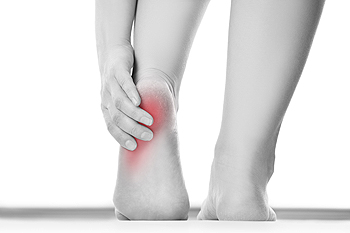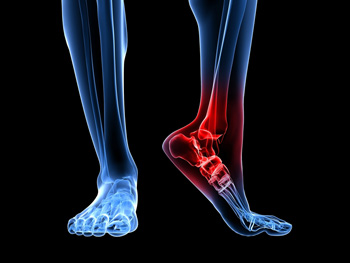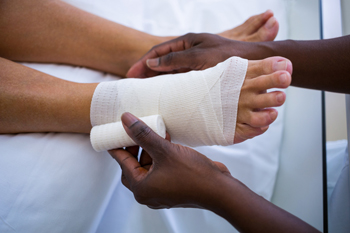Blog
 The ankle is designed to help move the foot in various directions as well as support the body. Many patients have ankle pain that is a result of a disease of the ankle joint, or from an injury that has occurred. A twisted ankle may be the result of unexpectedly stepping off of a curb which can affect the surrounding tendons and ligaments. Other medical conditions that can cause ankle pain include osteoporosis which may weaken the bones in the ankle leading to an increased risk of a fracture. If you have sprained or fractured your ankle, please speak with a podiatrist who can properly diagnose and treat your ankle injuries.
The ankle is designed to help move the foot in various directions as well as support the body. Many patients have ankle pain that is a result of a disease of the ankle joint, or from an injury that has occurred. A twisted ankle may be the result of unexpectedly stepping off of a curb which can affect the surrounding tendons and ligaments. Other medical conditions that can cause ankle pain include osteoporosis which may weaken the bones in the ankle leading to an increased risk of a fracture. If you have sprained or fractured your ankle, please speak with a podiatrist who can properly diagnose and treat your ankle injuries.
Ankle sprains are common but need immediate attention. If you need your feet checked, contact the podiatrists from Boston Common Podiatry. Our doctors can provide the care you need to keep you pain-free and on your feet.
How Does an Ankle Sprain Occur?
Ankle sprains take place when the ligaments in your ankle are torn or stretched beyond their limits. There are multiple ways that the ankle can become injured, including twisting or rolling over onto your ankle, putting undue stress on it, or causing trauma to the ankle itself.
What Are the Symptoms?
- Mild to moderate bruising
- Limited mobility
- Swelling
- Discoloration of the skin (depending on severity)
Preventing a Sprain
- Wearing appropriate shoes for the occasion
- Stretching before exercises and sports
- Knowing your limits
Treatment of a Sprain
Treatment of a sprain depends on the severity. Many times, people are told to rest and remain off their feet completely, while others are given an air cast. If the sprain is very severe, surgery may be required.
If you have suffered an ankle sprain previously, you may want to consider additional support such as a brace and regular exercises to strengthen the ankle.
If you have any questions please feel free to contact our office located in Boston, MA . We offer the newest diagnostic and treatment technologies for all your foot and ankle needs.
Those with diabetes may find that their feet are more prone to dryness, itchiness, bruising, cuts, scrapes, and sores. These seemingly minor issues can be dangerous for diabetic feet. Even small wounds may heal slowly and poorly, becoming infected, or develop into diabetic foot ulcers (DFU's) over time. Topical medications are treatments that are applied directly to the skin to treat a skin problem. There are various topical medications that may be used to address skin conditions on diabetic feet. These include medications that moisturize the skin, protect the skin from irritants, reduce itchiness, decrease pain, disinfect wounds and aid wound healing. If you have DFU's or other skin problems on your feet a podiatrist can help to find the correct treatment for you.
Wound care is an important part in dealing with diabetes. If you have diabetes and a foot wound or would like more information about wound care for diabetics, consult with the podiatrists from Boston Common Podiatry. Our doctors will assess your condition and provide you with quality foot and ankle treatment.
What Is Wound Care?
Wound care is the practice of taking proper care of a wound. This can range from the smallest to the largest of wounds. While everyone can benefit from proper wound care, it is much more important for diabetics. Diabetics often suffer from poor blood circulation which causes wounds to heal much slower than they would in a non-diabetic.
What Is the Importance of Wound Care?
While it may not seem apparent with small ulcers on the foot, for diabetics, any size ulcer can become infected. Diabetics often also suffer from neuropathy, or nerve loss. This means they might not even feel when they have an ulcer on their foot. If the wound becomes severely infected, amputation may be necessary. Therefore, it is of the upmost importance to properly care for any and all foot wounds.
How to Care for Wounds
The best way to care for foot wounds is to prevent them. For diabetics, this means daily inspections of the feet for any signs of abnormalities or ulcers. It is also recommended to see a podiatrist several times a year for a foot inspection. If you do have an ulcer, run the wound under water to clear dirt from the wound; then apply antibiotic ointment to the wound and cover with a bandage. Bandages should be changed daily and keeping pressure off the wound is smart. It is advised to see a podiatrist, who can keep an eye on it.
If you have any questions please contact our office located in Boston, MA . We offer the newest diagnostic and treatment technologies for all your foot and ankle needs.
Roughly 1 in 4 older adults fall annually, which is why it is important for people over 65 to practice various safety measures to reduce risks of falling. Exercises can be done to strengthen muscles and improve balance. Pharmaceuticals should be reviewed to eliminate any medicine that causes drowsiness or dizziness. Vision should be checked annually to update eyewear as prescriptions change. Homes should be made as fall-proof as possible by installing grab bars near toilets and in showers and railings on both sides of stairs. Clutter should be eliminated from walkways, bright lighting should be installed, and small rugs should be eliminated or taped down to avoid slippage. A trip to the podiatrist is also recommended for a thorough examination to ensure that feet and ankles are healthy. A gait analysis may also be performed to see if custom orthotics may help improve balance and mobility.
Preventing falls among the elderly is very important. If you are older and have fallen or fear that you are prone to falling, consult with the podiatrists from Boston Common Podiatry. Our doctors will assess your condition and provide you with quality advice and care.
Every 11 seconds, an elderly American is being treated in an emergency room for a fall related injury. Falls are the leading cause of head and hip injuries for those 65 and older. Due to decreases in strength, balance, senses, and lack of awareness, elderly persons are very susceptible to falling. Thankfully, there are a number of things older persons can do to prevent falls.
How to Prevent Falls
Some effective methods that older persons can do to prevent falls include:
- Enrolling in strength and balance exercise program to increase balance and strength
- Periodically having your sight and hearing checked
- Discuss any medications you have with a doctor to see if it increases the risk of falling
- Clearing the house of falling hazards and installing devices like grab bars and railings
- Utilizing a walker or cane
- Wearing shoes that provide good support and cushioning
- Talking to family members about falling and increasing awareness
Falling can be a traumatic and embarrassing experience for elderly persons; this can make them less willing to leave the house, and less willing to talk to someone about their fears of falling. Doing such things, however, will increase the likelihood of tripping or losing one’s balance. Knowing the causes of falling and how to prevent them is the best way to mitigate the risk of serious injury.
If you have any questions, please feel free to contact our office located in Boston, MA . We offer the newest diagnostic and treatment technologies for all your foot care needs.
 Plantar fasciitis is one of the most common causes of pain in the heel. This condition can occur when the plantar fascia, which is a band of tissue that runs from the bottom of the heel to the front of the foot, becomes inflamed or torn. Generally, plantar fasciitis is considered to be an overuse injury. There are other issues such as foot biomechanics, ill-fitted footwear, being overweight, or having tight calf muscles that can lead to an increased risk of plantar fasciitis as well. Plantar fasciitis usually results in heel pain that gradually worsens over time, tenderness when pressing onto the heel, and heel pain that is worse in the morning. Patients who notice any of the symptoms of heel pain or plantar fasciitis should consult with a podiatrist for a proper diagnosis and treatment for their condition.
Plantar fasciitis is one of the most common causes of pain in the heel. This condition can occur when the plantar fascia, which is a band of tissue that runs from the bottom of the heel to the front of the foot, becomes inflamed or torn. Generally, plantar fasciitis is considered to be an overuse injury. There are other issues such as foot biomechanics, ill-fitted footwear, being overweight, or having tight calf muscles that can lead to an increased risk of plantar fasciitis as well. Plantar fasciitis usually results in heel pain that gradually worsens over time, tenderness when pressing onto the heel, and heel pain that is worse in the morning. Patients who notice any of the symptoms of heel pain or plantar fasciitis should consult with a podiatrist for a proper diagnosis and treatment for their condition.
Plantar fasciitis is a common foot condition that is often caused by a strain injury. If you are experiencing heel pain or symptoms of plantar fasciitis, contact the podiatrists from Boston Common Podiatry. Our doctors can provide the care you need to keep you pain-free and on your feet.
What Is Plantar Fasciitis?
Plantar fasciitis is one of the most common causes of heel pain. The plantar fascia is a ligament that connects your heel to the front of your foot. When this ligament becomes inflamed, plantar fasciitis is the result. If you have plantar fasciitis you will have a stabbing pain that usually occurs with your first steps in the morning. As the day progresses and you walk around more, this pain will start to disappear, but it will return after long periods of standing or sitting.
What Causes Plantar Fasciitis?
- Excessive running
- Having high arches in your feet
- Other foot issues such as flat feet
- Pregnancy (due to the sudden weight gain)
- Being on your feet very often
There are some risk factors that may make you more likely to develop plantar fasciitis compared to others. The condition most commonly affects adults between the ages of 40 and 60. It also tends to affect people who are obese because the extra pounds result in extra stress being placed on the plantar fascia.
Prevention
- Take good care of your feet – Wear shoes that have good arch support and heel cushioning.
- Maintain a healthy weight
- If you are a runner, alternate running with other sports that won’t cause heel pain
There are a variety of treatment options available for plantar fasciitis along with the pain that accompanies it. Additionally, physical therapy is a very important component in the treatment process. It is important that you meet with your podiatrist to determine which treatment option is best for you.
If you have any questions, please feel free to contact our office located in Boston, MA . We offer the newest diagnostic and treatment technologies for all your foot care needs.
 Sever’s disease, also known as calcaneal apophysitis, is an overuse injury of the growth plate in the heel bone. This condition typically affects children between the ages of 8 and 14 who participate in sports or running and jumping activities. It is thought to be caused by the Achilles tendon pulling repetitively on the heel’s growth plate, creating tiny injuries that can become inflamed and painful. Sever's disease can affect either one foot or both feet at the same time. It affects both feet in about sixty percent of cases. This condition is typically treated with rest, footwear and activity modifications, and over the counter anti-inflammatory medications. If your child complains of heel pain, it is suggested that you take them to see a podiatrist right away.
Sever’s disease, also known as calcaneal apophysitis, is an overuse injury of the growth plate in the heel bone. This condition typically affects children between the ages of 8 and 14 who participate in sports or running and jumping activities. It is thought to be caused by the Achilles tendon pulling repetitively on the heel’s growth plate, creating tiny injuries that can become inflamed and painful. Sever's disease can affect either one foot or both feet at the same time. It affects both feet in about sixty percent of cases. This condition is typically treated with rest, footwear and activity modifications, and over the counter anti-inflammatory medications. If your child complains of heel pain, it is suggested that you take them to see a podiatrist right away.
Sever's disease often occurs in children and teens. If your child is experiencing foot or ankle pain, see the podiatrists from Boston Common Podiatry. Our doctors can treat your child’s foot and ankle needs.
Sever’s Disease
Sever’s disease is also known as calcaneal apophysitis, which is a medical condition that causes heel pain I none or both feet. The disease is known to affect children between the ages of 8 and 14.
Sever’s disease occurs when part of the child’s heel known as the growth plate (calcaneal epiphysis) is attached to the Achilles tendon. This area can suffer injury when the muscles and tendons of the growing foot do not keep pace with bone growth. Therefore, the constant pain which one experiences at the back of the heel will make the child unable to put any weight on the heel. The child is then forced to walk on their toes.
Symptoms
Acute pain – Pain associated with Sever’s disease is usually felt in the heel when the child engages in physical activity such as walking, jumping and or running.
Highly active – Children who are very active are among the most susceptible in experiencing Sever’s disease, because of the stress and tension placed on their feet.
If you have any questions, please feel free to contact our office located in Boston, MA . We offer the newest diagnostic and treatment technologies for all your foot care needs.
 Heel pain can have a variety of causes that range from bone damage like a bone bruise or stress fracture, to structural issues like plantar fasciitis or Achilles tendonitis. Plantar fasciitis is the most common cause of heel pain, and this occurs when the plantar fascia, which connects the heel to the toes along the bottom of the foot, becomes inflamed or torn. Children who are experiencing heel pain may be suffering from Sever’s disease. Sever’s disease occurs in active teenagers when the growth plate in the heel becomes inflamed. Patients who are struggling with heel pain should consult with a podiatrist for diagnosis. Upon diagnosis, a proper treatment method will be provided by your podiatrist.
Heel pain can have a variety of causes that range from bone damage like a bone bruise or stress fracture, to structural issues like plantar fasciitis or Achilles tendonitis. Plantar fasciitis is the most common cause of heel pain, and this occurs when the plantar fascia, which connects the heel to the toes along the bottom of the foot, becomes inflamed or torn. Children who are experiencing heel pain may be suffering from Sever’s disease. Sever’s disease occurs in active teenagers when the growth plate in the heel becomes inflamed. Patients who are struggling with heel pain should consult with a podiatrist for diagnosis. Upon diagnosis, a proper treatment method will be provided by your podiatrist.
Many people suffer from bouts of heel pain. For more information, contact the podiatrists of Boston Common Podiatry. Our doctors can provide the care you need to keep you pain-free and on your feet.
Causes of Heel Pain
Heel pain is often associated with plantar fasciitis. The plantar fascia is a band of tissues that extends along the bottom of the foot. A rip or tear in this ligament can cause inflammation of the tissue.
Achilles tendonitis is another cause of heel pain. Inflammation of the Achilles tendon will cause pain from fractures and muscle tearing. Lack of flexibility is also another symptom.
Heel spurs are another cause of pain. When the tissues of the plantar fascia undergo a great deal of stress, it can lead to ligament separation from the heel bone, causing heel spurs.
Why Might Heel Pain Occur?
- Wearing ill-fitting shoes
- Wearing non-supportive shoes
- Weight change
- Excessive running
Treatments
Heel pain should be treated as soon as possible for immediate results. Keeping your feet in a stress-free environment will help. If you suffer from Achilles tendonitis or plantar fasciitis, applying ice will reduce the swelling. Stretching before an exercise like running will help the muscles. Using all these tips will help make heel pain a condition of the past.
If you have any questions please contact our office located in Boston, MA . We offer the newest diagnostic and treatment technologies for all your foot and ankle needs.
When the ligaments that connect and support the ankle joint get stretched or torn during a physical activity or accident, an ankle sprain may occur. Ankle sprains are very common and are often recurrent because they sometimes go untreated, and therefore don’t heal properly. You may sprain your ankle while running or walking on uneven surfaces, making sudden movements or landing wrong after a jump during sports, or twisting your ankle wearing high heels. Ankle sprains are graded in severity from 1-3 with symptoms such as pain, bruising, swelling, instability, tenderness, and limitation of movement. If you believe you have sprained your ankle, contact a podiatrist who can properly diagnose you and use a variety of methods such as RICE (rest-ice-compression-elevation), bracing, physical therapy, medication and more to treat your ankle sprain and to help avoid chronic ankle instability.
Ankle pain can have many different causes and the pain may potentially be serious. If you have ankle pain, consult with the podiatrists from Boston Common Podiatry. Our doctors will assess your condition and provide you with quality foot and ankle treatment.
Ankle pain is any condition that causes pain in the ankle. Due to the fact that the ankle consists of tendons, muscles, bones, and ligaments, ankle pain can come from a number of different conditions.
Causes
The most common causes of ankle pain include:
- Types of arthritis (rheumatoid, osteoarthritis, and gout)
- Ankle sprains
- Broken ankles
- Achilles tendinitis
- Achilles tendon rupture
- Stress fractures
- Tarsal tunnel syndrome
- Plantar fasciitis
Symptoms
Symptoms of ankle injury vary based upon the condition. Pain may include general pain and discomfort, swelling, aching, redness, bruising, burning or stabbing sensations, and/or loss of sensation.
Diagnosis
Due to the wide variety of potential causes of ankle pain, podiatrists will utilize a number of different methods to properly diagnose ankle pain. This can include asking for personal and family medical histories and of any recent injuries. Further diagnosis may include sensation tests, a physical examination, and potentially x-rays or other imaging tests.
Treatment
Just as the range of causes varies widely, so do treatments. Some more common treatments are rest, ice packs, keeping pressure off the foot, orthotics and braces, medication for inflammation and pain, and surgery.
If you have any questions please feel free to contact our office located in Boston, MA . We offer the newest diagnostic tools and technology to treat your foot and ankle needs.
Blog Archives
- 2025
- 2024
- 2023
- 2022
- 2021
- 2020
- 2019











